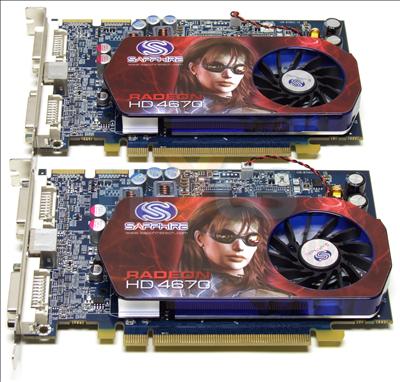Is two better than one?
Let's do some architecture comparisons and try to shed some light on to whether the Radeon HD 4670, run in two-board CrossFire, stands a chance against Radeon HD 4850.Please note the stated CrossFireX figures, shown in column two, are for two Radeon HD 4670 boards.
| Graphics cards | ATI Radeon HD 4670 GDDR3 | ATI Radeon HD 4670 GDDR3 XF | ATI Radeon HD 4850 GDDR3 |
|---|---|---|---|
| PCIe | PCIe 2.0 | ||
| GPU clock | 750MHz | 750MHz | 625MHz |
| Shader clock | 750MHz | 750MHz | 625MHz |
| Memory clock (effective) | 2,000MHz | 2,000MHz | 2,000MHz |
| Memory interface, size, and implementation | 128-bit, 512MB GDDR3 | 256-bit, 1,024MB, GDDR3 | 256-bit, 512MB, GDDR3 |
| Memory bandwidth | 32GB/sec | 64GB/sec | 64GB/sec |
| Manufacturing process | TSMC, 55nm | ||
| Transistor count | 514M | 1,028M | 965M |
| Die size | 146mm² | 292mm² | 260mm² |
| DirectX Shader Model | DX10.1, SM4.1 | ||
| Vertex, fragment, geometry shading (shared) | 320 FP32 scalar ALUs, MADD dual-issue (unified) | 640 FP32 scalar ALUs, MADD dual-issue (unified) | 800 FP32 scalar ALUs, MADD dual-issue (unified) |
| Peak GFLOP/s | 480 | 960 | 1,000 |
| Data sampling and filtering | 32ppc address and 32ppc bilinear INT8 filtering (16ppc FP16), max 16xAF | 64ppc address and 64ppc bilinear INT8 filtering (32ppc FP16), max 16xAF | 40ppc address and 40ppc bilinear INT8 filtering, (20ppc FP16) max 16xAF |
| Peak GTexel/s (bilinear) | 24 | 48 | 25 |
| Peak GPixel/s | 6 | 12 | 10 |
| ROPs | 8 | 16 | 16 |
| Peak TDP (claimed) | 59W | 108W | 110W |
| Power connectors (default clock) | None | None | 6-pin |
| Multi-GPU | CrossFireX - four-board | CrossFireX | CrossFireX four-board |
| Outputs (native) | 2 x dual-link DVI w/HDCP, DisplayPort, HDMI 7.1-channel | ||
| Hardware-assisted video-decoding engine | AMD UVD 2 - full H.264 and VC-1 decode | ||
| Reference cooler | single-slot | single-slot | single-slot |
| Retail price (default-clocked model) | £50-£55 | £100-£110 | £110-£125 |
What do you know: Radeon HD 4670 two-card CrossFire stacks up quite nicely against single-GPU Radeon HD 4850.
Overall memory bandwidth is the same. The math throughput is also very similar, with clock-speed making up for shader-count. The transistor-count and, to an extent, die-size and pricing are all pretty close, too.
Radeon HD 4670 XF has the edge in filtering, being endowed with a better shading-to-texturing ratio than HD 4850.
Power-draw, too, is eerily similar, and the non-3D feature-set is, for all intents and purposes, identical.
So, should the budget CrossFired pair be faster than a single-GPU '4850? The answer is yes and no. Pure on-paper specifications would lead us to believe that it can be, but the vagaries of multi-GPU rendering mean that linear increases are not always observed in games.
Seeing double? You bet.










